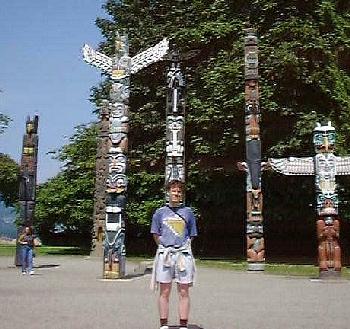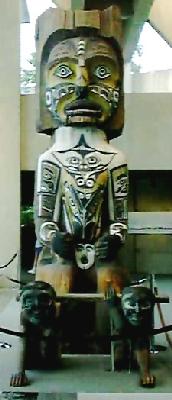
Vancouver
Part four - totem poles

Fergus with totem poles in Stanley Park, Vancouver
Monday 5th July - Monday 12th July 1999
One of the special attractions of British Columbia is the First Nations' art, embodied in the totem poles. One of the many misconceptions about the original inhabitants of North America revolves around the totem pole. Despite Holywood's best efforts to persuade us to the contrary, totem poles are in fact limited geographically to the Pacific Coast of Canada and Alaska - the plains Indians did not build them. They are a relatively recent innovation, and some historians of art and anthropologists feel that they are not best representative of the culture of the region, as they in fact post-date the arrival of the Europeans.
We encountered totem poles in a number of locations: in Stanley Park, at the Capilano Suspension Bridge, and in the UBC Museum of Anthropology, which has the world's largest collection of artefacts of the native peoples of the Pacific North-West coast. Today they number around 169,000 in British Columbia, some in the towns and cities, others in the reservations. The legal status of the First Nations and their rights to traditional lands and resources are today the subject of much discussion in Canada, a debate which recently led to the creation of a new province in northern Canada for the self-government of the Inuit peoples covering some one-sixth of the country and including most if not all of the northern islands.

Detail from a totem pole in Stanley Park, Vancouver
Contrary to the image portrayed by Hollywood and popular culture in general, totem poles were not a site of ritual sacrifices, and nor were they locations for ceremonial dancing. Instead they served a number of functions, some of them eminently practical. The carvings on individual poles told particular stories, sometimes traditional myths and legends, sometimes the life stories of real individuals whom they commemorated. Sometimes they served as tombstones for individuals; at other times they served as marker posts, delineating the borders of lands owned by individual bands or groups; in some cases they were used as wall posts around which "Big Houses" were built; and in other instances they were used as doorposts, either for houses or for mortuary houses.

A modern reproduction of coastal buildings
The picture above illustrates a number of traditional uses for totem poles. The main building in the centre of the picture has a totem pole in the centre as a support for the structure of a "Big House". Big Houses would be occupied by one or several extended families, with up to 30 or 40 individuals. The interior of the house would have a central fire pit with removable planks above the fireplace to allow smoke to escape and to allow shelter from the rain. The area around the fire pit would have partitions made of wood or blankets, giving individuals and family units a certain degree of privacy within the communal living area. The picture below shows a totem pole which served as a door post, with people entering through the gap at the front. The curved top of the figure would serve as a cup to support a cross-beam to form the basis of a ceiling. In other poles, the top would serve to hold a cask containing the corpse of a notable individual. The arrival of Europeans and forced Christianity meant that the practice of interrment became the norm, and the use of mortuary houses and poles died out, so to speak.

Totem pole in UBC Museum of Anthropology
Previous | Travel index | Family history | Romany | Main index